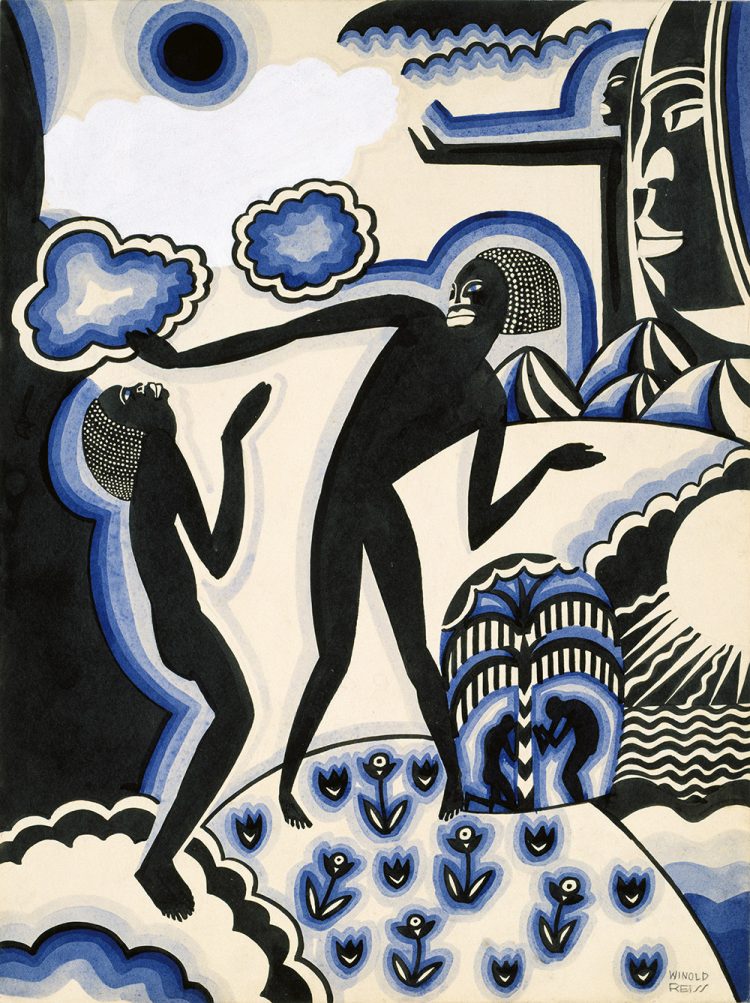While The Phillips Collection is closed, The Experiment Station will be sharing some of the great artwork featured in Riffs and Relations: African American Artists and the European Modernist Tradition, now on view through January 3, 2021.
Early in the 20th century, African art, displayed at ethnographic museums in Europe and circulated in publications, came to the attention of artists as source material for new and exciting possibilities. Yet the objects that arrived in Europe by way of colonialism were interpreted mainly through visual cues and without proper context. This set up an uneven power dynamic and a false dichotomy between “civilized” European and “primitive” African cultures. The European fascination with the art of Africans and other non-Western cultures became known as “Modernist Primitivism.”
In the 1920s and 30s, Harlem Renaissance cultural leader Alain Locke advised in The New Negro and other writings that African American artists draw upon European aesthetic models (including Cubism and German Expressionism) indebted to African art. He also encouraged artists to learn more about Africa to help define their modern identity. In their studies, they looked to photographs of African art featured in Locke’s publications and others and attended exhibitions, including the Museum of Modern Art’s 1935 African Negro Art, which encompassed over 600 objects primarily from European and American collections. Winold Reiss and Aaron Douglas were among the many artists who engaged with African art in their own work.

Winold Reiss, African Phantasy: Awakening, c. 1925, Ink, watercolor, and gouache on paper, 19 3/4 x 14 7/8 in., Smithsonian American Art Museum, Washington, DC, Museum purchase
An immigrant from Germany, artist and illustrator Winold Reiss made a great impact on the visual culture of the Harlem Renaissance. Reiss illustrated Alain Locke’s The New Negro, a publication in which modern black identities were explored and imagined. Reiss’s 1920s modernist style was inflected with the latest Art Deco trends as well as the European modernist vogue for African art. African Phantasy: Awakening was published in the first edition of The New Negro. In an imaginative African setting, Reiss depicts a black couple dancing among patterns and symbols that recall a mythical African past. In spite of some stereotypical aspects, Reiss’s Jazz Age fantasy was of its time. His illustrations in numerous publications had an indelible influence on the development on African American modernists, especially his student Aaron Douglas.

Aaron Douglas, The Negro in an African Setting (later variant of panel 1 of Aspects of Negro Life), 1954, Oil on canvas board, 20 x 24 in., Collection of Steven L. Jones, Philadelphia and Chicago
The early works of Aaron Douglas (b. 1899, Topeka, KS; d. 1979, Nashville, TN) defined the images of the New Negro movement. By synthesizing Alain Locke’s charge to combine African arts and modernist style, he created a new idiom through which African American stories could be told. His aesthetic was heavily influenced by his teacher German modernist Winold Reiss who also advised him to study the arts of Africa.
Douglas is highly regarded for his epic four-panel mural cycle, Aspects of Negro Life (1934), commissioned by the Works Progress Administration (WPA) for the 135th Street branch of the New York Public Library. Adopting aspects of Cubism, he employed his signature aesthetic to chronicle the movement of African Americans from an African setting through slavery and Reconstruction to the vagaries of modern identity. The Negro in an African Setting, a variant of the first panel in the mural cycle, features many of the same elements of the original mural—men and women dancing and playing instruments, an African styled sculpture, and a border of lush foliage—all animated by concentric circles that radiate outward. New to the scene is a lone female observing from the margins.

We just watched your Zoom presentation of the virtual tour on Riffs and Relations; It was WONDERFUL! Thank You, Adrienne and Renee, and all the Phillips Collection folks involved. We are so looking forward to seeing the exhibit in person.
Patricia and Henry Ferrand